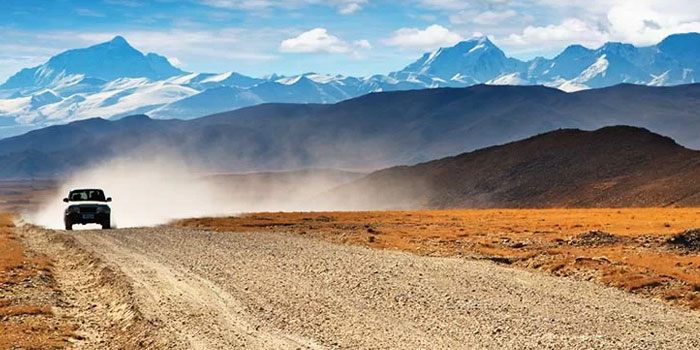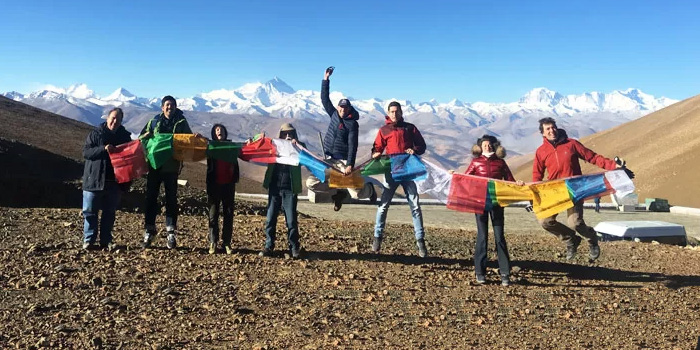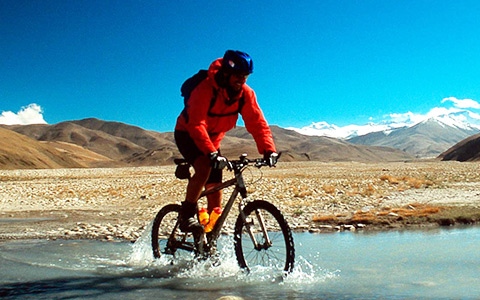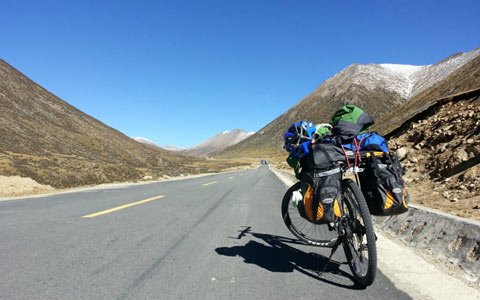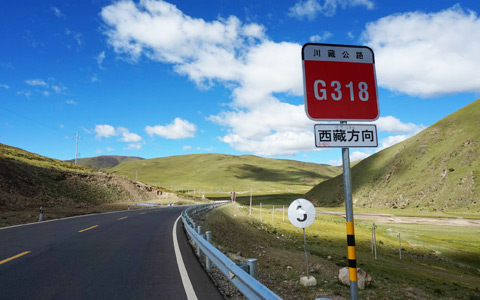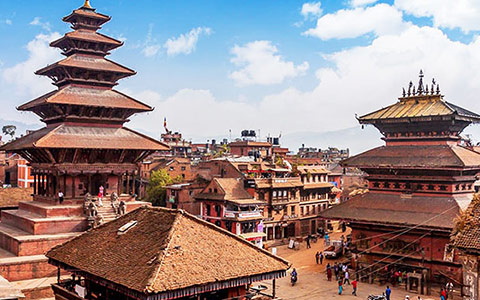Elevation of Lhasa and Kathmandu: How to Safely Adapt Yourself to Altitude Change to Travel across the Himalayas
As the mighty Himalayas straddles the border between China and Nepal, traveling from Lhasa to Kathmandu or in reverse has become the classic and only travel route to appreciate the imposing Himalayas by road.
However, due to the dramatic altitude change between Lhasa and Kathmandu, it poses a challenge for travelers embarking on a Tibet-Nepal tour by road, esp. when traveling from Kathmandu (1,400m) to Lhasa (3,656 m).
So, in this tutorial, we will walk you through the elevation of Lhasa and Kathmandu, so you can safely adapt yourself to altitude change for the Tibet Nepal Tour or the other way around.
 Elevation of Kathmandu: Oxygen-rich Kathmandu Valley, Nestling at the Foot of the Himalayas
Elevation of Kathmandu: Oxygen-rich Kathmandu Valley, Nestling at the Foot of the Himalayas
 How to Safely Adapt Yourself to Altitude Rise from Kathmandu to Lhasa or in Reverse
How to Safely Adapt Yourself to Altitude Rise from Kathmandu to Lhasa or in Reverse
Elevation of Lhasa: on the Tibetan Plateau with around 30% Lower Oxygen Content in Air than that at Sea Level
Lhasa is one of the highest cities in the world. Located on the Tibetan Plateau, the 'Roof of the World,' the Lhasa city's elevation is 3,656 meters (11,995 feet). At that level, the oxygen content of the air is approximately 30% lower than at sea level. Without enough time for acclimatization, people coming from lower-elevation regions can experience symptoms of altitude sickness.
The valley where Lhasa sits was carved by the Kyichu River, a tributary of the Yarlung Tsangpo River. It's surrounded by the Nyenchen Tanglha Mountains to the north and the Himalayas to the south. The local skyline is dominated by Red Hill, Marpo Ri, where Potala Palace looks over the city. Beyond Lhasa, the Tibetan Plateau stretches with vast expanses of grasslands and rolling hills.
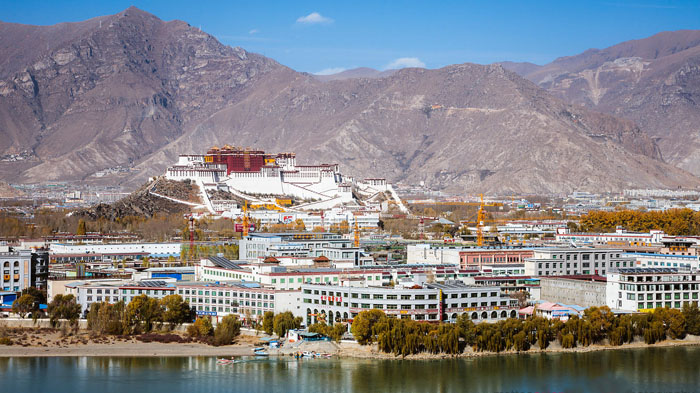 Marvel at the Potala Palace and Lhasa valley from afar.
Marvel at the Potala Palace and Lhasa valley from afar.
Elevation of Kathmandu: Oxygen-rich Kathmandu Valley, Nestling at the Foot of the Himalayas
The Kathmandu Valley is a region of fertile plains, lush vegetation, and terraced fields. At the foot of the Himalayas, Kathmandu, at 1,400m (4,593 ft), is well below the surrounding peaks.
The Langtang Mountain Range to the north and Shivapuri and Nagarjun hills to the northwest are a dramatic backdrop to the city, and show off the diverse topography of the region.
Not being very high, the oxygen content around Kathmandu is only slightly lower than at sea level. The air is fresh and easy to breathe, and it's a good starting point for an overland journey.
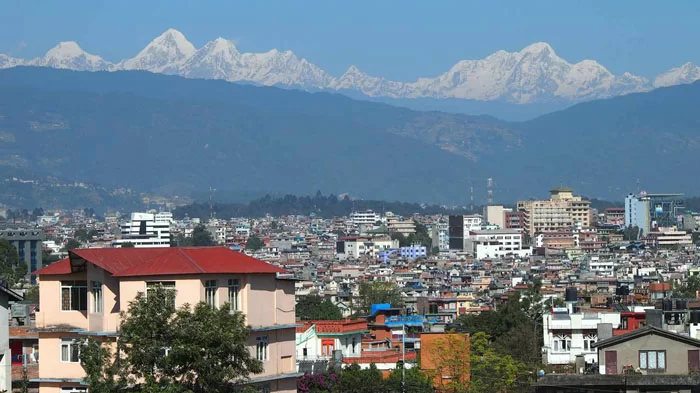 Kathmandu valley, Lush forest and fertile land.
Kathmandu valley, Lush forest and fertile land.
Altitude Change from Kathmandu to Lhasa: Steep Altitude Rise from Kathmandu Valley to Soaring Tibetan Plateau
Compared with traveling from Lhasa to Kathmandu, where you descend from the roof of the world to oxygen-rich Kathmandu Valley, traveling from Kathmandu to Lhasa proves to be more challenging in terms of steep altitude rise.
However, no worries! Here, we show you the details of the elevation change from Kathmandu to Lhasa, based on the classic 8-day Kathmandu to Lhasa overland tour. So, you will know where the high mountain passes are and how to plan a safe journey through the mighty Himalayas.
Altitude change in the first two days: start from Kathmandu at 1,400 meters (4,600 feet) and ascend gradually, stopping overnight at Rasuwa Gadi at 1,800 meters (5,905 feet) and Gyirong at 2,700 meters (8,858 feet) to allow you time to adapt.
Altitude change on day three: there is a rapid ascent through two high-altitude mountain passes, Kong Tang Lamu Pass 5,236 meters (17,178 feet) and Gawula Pass 5,198 meters (17,053 feet), before arriving at Everest Base Camp 5,200 meters (17,060 feet). Because of the rapid ascent, you'll descend to Tingri at 4,300 meters (14,107 feet) and spend the night there.
Altitude change on day four: The next stop is Shigatse, at 3,900 meters (12,795 feet).
Altitude Change from day five: Then, a rapid climb to Gampala Pass at 5,250 meters (17,224 feet) before descending to Lhasa at 3,656 meters (11,995 feet).
How to Safely Adapt Yourself to Altitude Rise from Kathmandu to Lhasa or in Reverse
Safely adapting to altitude changes is critical for a safe and pleasant Nepal Tibet tour or in reverse.
Two guidelines help visitors avoid risk: First, give yourself time to acclimatize, and second, "travel high, stay low." As the best-known local Tibet travel agency, we have been helping visitors have an amazing Tibet experience since 1984. Our tours are designed with experience and science to minimize the risks of altitude sickness.
The recommended 8-day Kathmandu to Lhasa Overland Tour gives you time to acclimatize before reaching Everest Base Camp. Overnight stays in Rasuwa Gadi and Gyirong before ascending the Himalayas let you see the beautiful scenery while your body adapts to the changes. You then 'travel high' to EBC through the high-altitude passes and 'stay low' spending overnight in Tingri.
If you start to experience symptoms of altitude sickness at any time, it's important to tell your guide right away. The common signs are dizziness, headache, nausea, or shortness of breath.
Descending to a lower altitude is the first step to avoid more serious effects. Altitude sickness medication, such as acetazolamide (Diamox), is commonly recommended. Speak to your doctor before traveling to get medical advice.
Traveling with our experienced guides will help you stay safe, and you should also make sure to stay hydrated. Dehydration makes the symptoms of altitude sickness worse.
Take plenty of rest during the trip when you can, and eat carbohydrate-rich foods to fuel your body's metabolism. It is also advisable to avoid alcohol and tobacco while at high altitudes.
Besides the Altitude Variation between Lhasa and Kathmandu, Travel Season & Travel Formalities Also Matter
Altitude sickness results from the body's reaction to lower oxygen content in the air. During summer seasons(July & August), the oxygen content is higher, and the risks of altitude sickness are lower. The warm seasons, particularly spring and autumn, also have safer road conditions. Most places, except the high-altitude passes, will be free of ice, making access easier.
Travel documents are different depending on whether you start from Kathmandu or Lhasa. International travelers entering Tibet from Nepal must obtain a Chinese Group Visa from the Chinese Embassy in Kathmandu. The group visa takes 3-4 business days to process, and the Tibet Travel Permit is issued together with the visa. We will apply for the group visa and Tibet Travel Permit on your behalf and deliver them to your hotel.
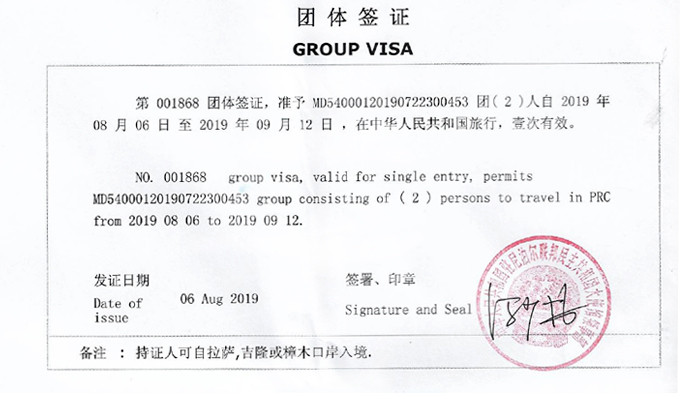 A Sample of China Group Visa.
A Sample of China Group Visa.
Starting from Lhasa, you will first need to obtain a Chinese Tourist Visa. This can be easily applied for at your nearest Chinese Embassy or Consulate. After obtaining the visa, we will apply for the Tibet Travel Permit for you. It usually takes 14 business days and make sure you submit your application at 20 days before your depature to Lhasa.
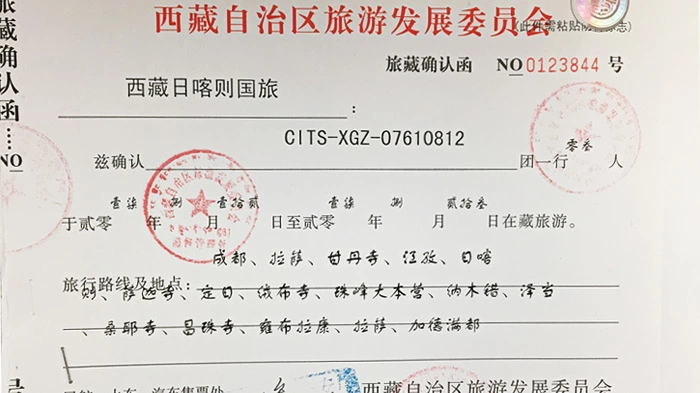 A sample of Tibet Travel Permit.
A sample of Tibet Travel Permit.
Other permits are needed to visit areas outside of Lhasa. The Alien's Travel Permit, Military Permit, and Foreign Affairs Permit cover areas such as the Everest Region, Mount Kailash, and the Sino-Nepal Border. These can be applied for after you arrive, and we will handle the processing. We have a 100% success rate in applying for the various permits, and we guarantee you a successful trip.
Conclusion
Concerns about altitude sickness shouldn't stop you from traveling to Tibet. With the right knowledge and our carefully designed tours, the risks of serious symptoms are low. Our experienced guides are well-trained to deal with altitude sickness. They will respond quickly to ensure a fast recovery so your tour can continue. Find out more about our Lhasa-Kathmandu overland tours, or contact us to for free inquiry.

Kungga Dundruk, often respectfully referred to as “Manager Kunga”, is the most revered and legendary Tibetan guide in our team.
Currently working as a customer service manager in Lhasa, Kunga used to study business overseas and got his Bachelor of Business in Nepal and India before moving back to his homeland. With pure passion for life and unlimited love for Tibet, Kunga started his guide career as early as 1997.
As a legendary Tibetan guide with 22 years of guide experience, Kunga was awarded the Gold Medalist of China’s Best Tour Guide in 2019, marking the pinnacle of his career. Today, Kunga loves sharing his wealth of Tibetan knowledge through travel articles and stands ready to offer prompt support whenever our guests need help in Lhasa.
Related Articles & Posts
-

Lhasa - Gyantse - Shigatse - Everest Base Camp - Shigatse - Lhasa
USD939
View Details -

Lhasa - Gyantse - Shigatse - E.B.C - Saga - Kailash Trek - Darchen - Lake Manasarovar - Saga - Gyirong - Tingri - Lhasa
USD2059
View Details -

10 Days Lhasa to Everest Base Camp and Namtso Lake Small Group Tour
Lhasa - Gyantse - Shigatse - EBC - Shigatse - Lhasa - Namtso Lake - Damxung - Lhasa
USD1289
View Details -

8 Days Driving Across Himalaya Overland Adventure from Kathmandu to Lhasa
Kathmandu - Gyirong - Everest Base Camp - Tingri - Shigatse - Gyantse - Lhasa
USD1069
View Details -

4 Days Lhasa Impression Small Group Tour: Explore the Heart of Tibet and Mingle with the Locals
Lhasa
USD509
View Details -

Lhasa - Gyantse - Shigatse - Everest Base Camp - Gyirong - Kathmandu
USD979
View Details -

Lhasa - Gyantse - Shigatse- Lhasa
USD799
View Details -

13 Day Lhasa, Mt. Everest, Mt. Kailash, Lake Manasarovar and Kathmandu Adventure Tour
Lhasa - Gyantse - Shigatse - EBC - Saga - Darchen - Kailash Trek - Darchen - Saga - Gyirong - Kathmandu
USD2059
View Details


.jpg)



